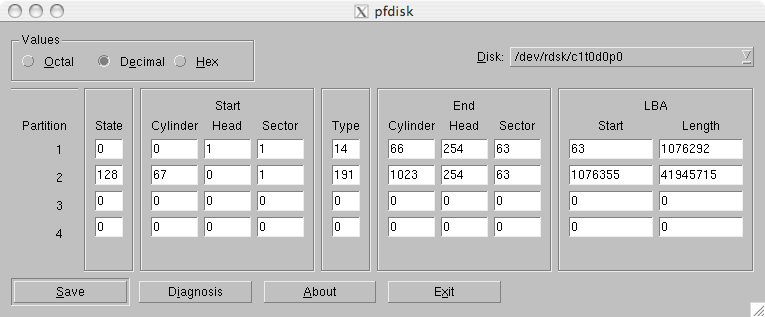
| Index | Software |
At the end of 2005, mostly working.
February 2006, fixed a few issues.
March 2006. Fixed some layout issues. Fixed quite a few bugs in the calculation of CHS values from LBA.
Mid March 2006. Completed setting CHS from LBA.
September 2007. Tested on my new HP workstation.
I would appreciate any feedback.
GPL, using Qt 3.3.6. I'm no fan of the GPL, but using Qt leaves me no choice (well, I could buy a commercial Qt licence). I leave it to your conscience to make a donation. I don't wish to make any profit out of this. You can contact me here
Taken on my Mac, ssh logged into my PC running Solaris 10u4.

First you'll need the dynamic libraries.
Download a binary compiled for Solaris 10 x86 pfdisk_bin.tar.bz2.
The source code pfdisk_src.tar.bz2.
Uncompress and untar the file (bin and lib). I suggest that you create a little script that contains
#!/bin/sh
/etc/init.d/volmgt stop
LD_LIBRARY_PATH=[path to directory containing pfdisk and libraries]
export LD_LIBRARY_PATH
[path to directory containing pfdisk and libraries]/pfdisk
/etc/init.d/volmgt start
Then run the script as root. The application won't start if you are not root. Stopping vold is optional. If vold is running then you may get warnings about being unable to open vold-controlled devices.
Tested configurations Basically, it "works on my two machinesTM". That is a PIII running Solaris 10, SCSI disks only, and a dual Opteron 2220 also running Solaris 10, SAS disks only. I did try it briefly on my wife's IDE-equipped PC. That's pretty a slim test coverage.
A basic intro to multibooting
A non-authoritative guide to cross-OS filesystem mounting.
You may also be interested in my ports of the Linux ext2fs driver, which can be found back at the main software page.
The app will have the appearance of (now) Norton ptedit, but with a bit more intelligence. I do not intend making a tool 'for dummies' like Partition Magic, and neither do I intend adding filesystem formatting functions. This tool will edit the partition table(s) and that's all. If you are a dummy, then please stop now.
The most common use that I foresee is for someone that wants to multiboot, and after installing Solaris, they want to fix the partition table(s) so that the CHS values correspond to the LBA values. However, I must say that the usefulness of this application (latter half of 2005) is somewhat limited by two factors. Firstly, with the advent of OpenSolaris, it seems to me quite likely that a fixed version of fdisk for Solaris x86 might see the light of day. The second factor is the fact that current hard disks have completely outgrown the CHS geometry mechanism. A 140Gbyte disk, split into 4 equal 35Gbyte partitions will only have the start of the 1st partition fall within the CHS geometry limitations. [which is always the case, no matter how big the disk].
Here are my milestones for the project:
I'm not going to commit myself to any hard timescale - I'll be doing this in my spare time in the evenings, and I do have family commitments. I started this project back in the Summer of 2004, and it looks like it'll be more or less complete by October 2005. I know that's pitiful progress.
There are a few other things that I'd like to do:
At the moment I'm using Solaris 10. I do have the Solaris 7, 8 and 9 media, but I don't intend building on those platforms unless there really is demand.
Copyright © Paul John Floyd 2004 - 2007.